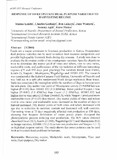Response of sweetpotato dual purpose varieties to harvesting regime

View/
Date
2011-09Author
Maina, Joyce
Agili, Sammy
Wamatu, Jane
Lukuyu, Ben
Gachuiri, Charles
Manoa, Lenita
Language
enMetadata
Show full item recordAbstract
Feeds are a major constraint to livestock production in Kenya. Sweetpotato
dual purpose varieties can be used to reduce feed resource competition and
provide high quality livestock feeds during dry seasons. A study was done to
evaluate the dry matter yields of six sweet potato varieties. Specific objectives
were to determine dry matter yield of vines and tubers, root to vine ratios,
marketable roots, and performance of the six varieties at different harvesting
regimes (75 and 150 days post planting).The varieties tested were Gweri,
Kemb-23, Naspot-l , Musinyamu, Wagabolige and 103001.152. The research
was conducted at the Kabete Campus Field Station, University of Nairobi and
was laid out in a split plot randomised block design replicated three times.
Varieties constituted the main plots while the numbers of days to harvest were
the sub-plots. Dry matter vine yield of Musinyamu variety (3.9 tDM/ha) was
higher (P<0.05) than 103001.152 (1.3 tDM/ha). Tuber yield of Naspot-I was
higher (P<0.05) (5.1 tDMlha) than Gweri (1.2 tDMlha); 103001.152 had
higher root to vine ratio (3.0) than Gweri (0.3), while Naspot-I produced more
marketable roots (P<0.05) than Gweri. Dry matter yields of vines and tubers
root to vine ratios and marketable roots increased as the number of days to
harvest increased. Dry matter yields of both vines and tubers increased with
age due to reduction in moisture content and increased cell wall contents.
Harvesting vines at 75 days negatively affected root production at 150 days,
showing that frequent defoliation of sweet potato plants disrupted the
photosynthetic process reducing root production. The RIV ratios obtained
classified Gweri (0.3), Kemb-23 (0.8), Wagabolige (0.7) and Musinyamu (0.6)
as forage varieties, 103001.152 (3.0) as low root production and Naspot-I (1.7)
as high dual purpose variety. The study shows that sweet potatoes can be used
both as livestock feeds and food for humans.
Citation
Optimimization of Agricultural Value Chains for sustainable DevelopmentSponsorhip
National Council of Science and Technology, The Kenya Seed CompanyPublisher
Faculty of Agriculture, University of Nairobi
Description
Oral presentation at aGRO 2011 Biennial Conference
